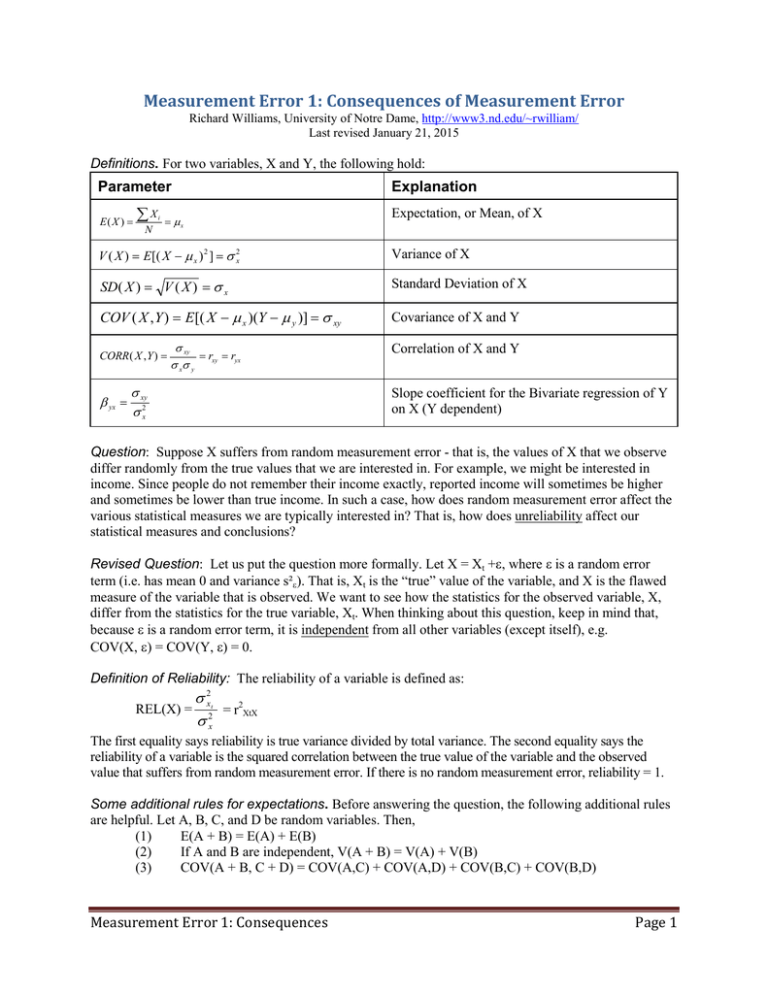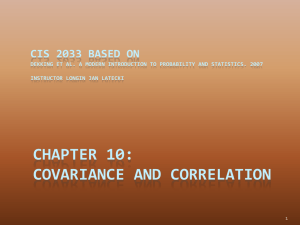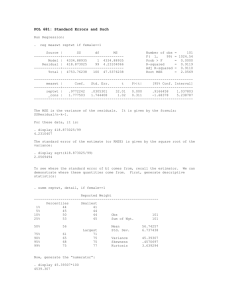Measurement Error 1: Consequences of Measurement Error ∑ Parameter Explanation
advertisement

Measurement Error 1: Consequences of Measurement Error Richard Williams, University of Notre Dame, http://www3.nd.edu/~rwilliam/ Last revised January 21, 2015 Definitions. For two variables, X and Y, the following hold: Parameter E( X ) = ∑X N i Explanation Expectation, or Mean, of X = µx V ( X ) = E[( X − µ x ) 2 ] = σ 2x Variance of X SD( X ) = V ( X ) = σ x Standard Deviation of X COV ( X , Y ) = E[( X − µ x )(Y − µ y )] = σ xy Covariance of X and Y CORR( X , Y ) = β yx = σ xy =r =r σ xσ y xy yx σ xy σ 2x Correlation of X and Y Slope coefficient for the Bivariate regression of Y on X (Y dependent) Question: Suppose X suffers from random measurement error - that is, the values of X that we observe differ randomly from the true values that we are interested in. For example, we might be interested in income. Since people do not remember their income exactly, reported income will sometimes be higher and sometimes be lower than true income. In such a case, how does random measurement error affect the various statistical measures we are typically interested in? That is, how does unreliability affect our statistical measures and conclusions? Revised Question: Let us put the question more formally. Let X = Xt +ε, where ε is a random error term (i.e. has mean 0 and variance s²ε). That is, Xt is the “true” value of the variable, and X is the flawed measure of the variable that is observed. We want to see how the statistics for the observed variable, X, differ from the statistics for the true variable, Xt. When thinking about this question, keep in mind that, because ε is a random error term, it is independent from all other variables (except itself), e.g. COV(X, ε) = COV(Y, ε) = 0. Definition of Reliability: The reliability of a variable is defined as: σ 2x REL(X) = 2 = r2XtX σx t The first equality says reliability is true variance divided by total variance. The second equality says the reliability of a variable is the squared correlation between the true value of the variable and the observed value that suffers from random measurement error. If there is no random measurement error, reliability = 1. Some additional rules for expectations. Before answering the question, the following additional rules are helpful. Let A, B, C, and D be random variables. Then, (1) E(A + B) = E(A) + E(B) (2) If A and B are independent, V(A + B) = V(A) + V(B) (3) COV(A + B, C + D) = COV(A,C) + COV(A,D) + COV(B,C) + COV(B,D) Measurement Error 1: Consequences Page 1 Hypothetical Data. To help illustrate the points that will follow, we create a data set where the true measures (Yt and Xt) have a correlation of .7 with each other – but the observed measures (Y and X) both have some degree of random measurement error, and the reliability of both is .64. The way I am constructing the data set, using the corr2data command, there will be no sampling variability, i.e. we can act as though we have the entire population. . . . . matrix input corr = (1,.7,0,0\.7 ,1,0,0\0,0,1,0\0,0,0,1) matrix input sd = (4,8,3,6) matrix input mean = (10,7,0,0) corr2data Yt Xt ey ex, corr(corr) sd(sd) mean(mean) n(500) (obs 500) . * Create flawed measures with random measurement error . gen Y = Yt + ey . gen X = Xt + ex Effects of Unreliability A. For the mean: E(X) = E(Xt + ε) = E(Xt) + E(ε) = E(Xt) [Expectations rule 1] NOTE: Remember, since errors are random, ε has mean 0. Implication: Random measurement error does not bias the expected value of a variable - that is, E(X) = E(Xt) B. For the variance: V(X) = V(Xt + ε) = V(Xt) + V(ε) [Expectations rule 2] NOTE: Remember, COV(Xt, ε) = 0 because ε is a random disturbance. Implication: Random measurement error does result in biased variances. The variance of the observed variable will be greater than the true variance. A & B illustrated with our hypothetical data. We see that the flawed, observed measures have the same means as the true measures – but their variances & standard deviations are larger: . sum Yt Y Xt X Variable | Obs Mean Std. Dev. Min Max -------------+-------------------------------------------------------Yt | 500 10 4 -2.639851 22.83863 Y | 500 10 5 -3.706503 26.55569 Xt | 500 7 8 -16.16331 28.80884 X | 500 7 10 -23.81675 38.49127 Measurement Error 1: Consequences Page 2 C. For the covariance (we’ll let Yt stand for the perfectly measured Y variable): COV(X,Yt) = COV(Xt + ε, Yt) = COV(Xt, Yt) + COV(ε, Yt) = COV(Xt, Yt) [Expectations rule 3] NOTE: Remember, COV(ε,Yt) = 0 because ε is a random disturbance. Implication: Covariances are not biased by random measurement error. C illustrated with our hypothetical data. Random measurement error in X does NOT affect the covariance: . corr Yt Xt X, cov (obs=500) | Yt Xt X -------------+--------------------------Yt | 16 Xt | 22.4 64 X | 22.4 64 100 D. For the correlation: rxyt = σXY σ XY σ XY = , rx y t = . σ X σY σ X σY σ XσY t t t t t t t t t t Thus, when X and Yt covary positively, CORR(X,Yt) ≤ CORR(Xt,Yt) Implication: Random measurement error produces a downward bias in the bivariate correlation. This is often referred to as attenuation. D with hypothetical data. The correlation is attenuated by random measurement error: . corr Yt Xt X (obs=500) | Yt Xt X -------------+--------------------------Yt | 1.0000 Xt | 0.7000 1.0000 X | 0.5600 0.8000 1.0000 Note that the correlation between X and Xt is .8 – and that the correlation between X and Yt (.56) is only .8 times as large as the correlation between Xt and Yt (.7). Also, the .8 correlation between X and Xt means that the reliability of X is .64. Measurement Error 1: Consequences Page 3 E. For ßYtX: (Yt is perfectly measured, X has random measurement error) σ , βYtXt = XtYt βYtX = σ XYt 2 σ Xt2 σX Thus, when X and Yt covary positively, ßYtX ≤ ßYtXt Implication: Random measurement error in the Independent variable produces a downward bias in the bivariate regression slope coefficient. E with hypothetical data. In a bivariate regression, random measurement error in X causes the slope coefficient to be attenuated, i.e. smaller in magnitude. First we run the regression between the true measures, and then we run the regression of Yt with the flawed measure X: . reg Yt Xt Source | SS df MS -------------+-----------------------------Model | 3912.16007 1 3912.16007 Residual | 4071.84001 498 8.17638555 -------------+-----------------------------Total | 7984.00008 499 16.0000002 Number of obs F( 1, 498) Prob > F R-squared Adj R-squared Root MSE = = = = = = 500 478.47 0.0000 0.4900 0.4890 2.8594 -----------------------------------------------------------------------------Yt | Coef. Std. Err. t P>|t| [95% Conf. Interval] -------------+---------------------------------------------------------------Xt | .35 .0160008 21.87 0.000 .3185627 .3814373 _cons | 7.55 .169994 44.41 0.000 7.216006 7.883994 -----------------------------------------------------------------------------. reg Yt X Source | SS df MS -------------+-----------------------------Model | 2503.78247 1 2503.78247 Residual | 5480.21761 498 11.004453 -------------+-----------------------------Total | 7984.00008 499 16.0000002 Number of obs F( 1, 498) Prob > F R-squared Adj R-squared Root MSE = = = = = = 500 227.52 0.0000 0.3136 0.3122 3.3173 -----------------------------------------------------------------------------Yt | Coef. Std. Err. t P>|t| [95% Conf. Interval] -------------+---------------------------------------------------------------X | .224 .0148503 15.08 0.000 .1948231 .2531769 _cons | 8.432 .1811488 46.55 0.000 8.07609 8.78791 ------------------------------------------------------------------------------ Note that X has a reliability of .64 – and the slope coefficient using the flawed X (.224) is only .64 times as large as the slope coefficient using the perfectly measured Xt (.35). Measurement Error 1: Consequences Page 4 F. For ßYXt: (Now Y is measured with random error, while Xt is measured perfectly) βYXt = σXY , σ 2X t t βY X = t t σXY . Thus, ßYXt = ßYtXt σ 2X t t t Implication: Random measurement error in the Dependent variable does not bias the slope coefficient. HOWEVER, it does lead to larger standard errors. Recall that the formula for the standard error of b is sb = s 1 − R2 * Y ( N − K − 1) s X When you have random measurement error in Y, R2 goes down because of the previously noted downward bias. This increases the numerator. Also, the variance of Y goes up, which further increases the standard error. F with hypothetical data. Random measurement error in Y does not cause the slope coefficient to be biased – but it does cause the standard error for the slope coefficient to be larger and the t value smaller. Again we run the true regression followed by the regression of Y with Xt. . reg Yt Xt Source | SS df MS -------------+-----------------------------Model | 3912.16007 1 3912.16007 Residual | 4071.84001 498 8.17638555 -------------+-----------------------------Total | 7984.00008 499 16.0000002 Number of obs F( 1, 498) Prob > F R-squared Adj R-squared Root MSE = = = = = = 500 478.47 0.0000 0.4900 0.4890 2.8594 -----------------------------------------------------------------------------Yt | Coef. Std. Err. t P>|t| [95% Conf. Interval] -------------+---------------------------------------------------------------Xt | .35 .0160008 21.87 0.000 .3185627 .3814373 _cons | 7.55 .169994 44.41 0.000 7.216006 7.883994 -----------------------------------------------------------------------------. reg Y Xt Source | SS df MS -------------+-----------------------------Model | 3912.16001 1 3912.16001 Residual | 8562.84011 498 17.194458 -------------+-----------------------------Total | 12475.0001 499 25.0000002 Number of obs F( 1, 498) Prob > F R-squared Adj R-squared Root MSE = = = = = = 500 227.52 0.0000 0.3136 0.3122 4.1466 -----------------------------------------------------------------------------Y | Coef. Std. Err. t P>|t| [95% Conf. Interval] -------------+---------------------------------------------------------------Xt | .35 .0232035 15.08 0.000 .3044111 .3955889 _cons | 7.55 .2465171 30.63 0.000 7.065658 8.034342 Measurement Error 1: Consequences Page 5 Additional implications • When you have more than one independent variable, random measurement error can cause coefficients to be biased either upward or downward. As you add more variables to the model, all you can really be sure of is that, if the variables suffer from random measurement error (and most do) the results will probably be at least a little wrong! • Reliability is a function of both the total variance and the error variance. True variance is a population characteristic; error variance is a characteristic of the measuring instrument. • The fact that reliabilities differ between groups does not necessarily mean that one group is more “accurate.” It may just mean that there is less true variance in one group than there is in another. • Comparisons of any sort can be distorted by differential reliability of variables. For example, if comparing effects of two variables, one variable may appear to have a stronger effect simply because it is better measured. If comparing, say, husbands and wives, the spouse who gives more accurate information may appear more influential. For a more detailed discussion of how measurement error can affect group comparisons, see Thomson, Elizabeth and Richard Williams (1982) “Beyond wives family sociology: a method for analyzing couple data” Journal of Marriage and the Family Vol 44 999:1008 Dealing with measurement error. For the most part, this is a subject for a research methods class or a more advanced statistics class. I’ll toss out a few ideas for now: • Collect better quality data in the first place. Make questions as clear as possible. • Measure multiple indicators of concepts. When more than one question measures a concept, it is possible to estimate reliability and to take corrective action. For a more detailed discussion on measuring reliability, see Reliability and Validity Assessment, by Edward G. Carmines and Richard A. Zeller. 1979. Paper # 17 in the Sage Series on Quantitative Applications in the Social Sciences. Beverly Hills, CA: Sage. • Create scales from multiple indicators of a concept. The scales will generally be more reliable than any single item would be. In SPSS you might use the FACTOR or RELIABILITY commands; in Stata relevant commands include factor and alpha. • Use advanced techniques, such as LISREL, which let you incorporate multiple indicators of a concept in your model. Ideally, LISREL “purges” the items of measurement error hence producing unbiased estimates of structural parameters. In Stata 12+, this can also be done with the sem (Structural Equation Modeling) command. Measurement Error 1: Consequences Page 6







